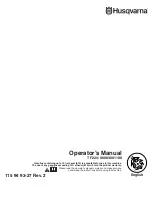
13
GB
3. Function
The Aerator can be used for removing matting and moss in the
lawn as well as for cutting flat-rooting ranks.
During aeration, the lawn must not contain seeds, be wet or too
dry.
To maintain a well-cared-for lawn, we recommend aerating it twice
a year: once in the spring and once in the autumn. This improves
the lawn’s intake of water, air and nutrients considerably.
Prior to aeration, mow the lawn so it is as short as possible, but
never reduce its height by more than 1/3.
Recommendation: the shorter you mow your lawn, the easier
it is to aerate, thus lessening the strain on the Aerator and in-
creasing the lifetime of the aerator cylinder.
Remaining in one spot too long, or aerating if the ground is wet
or too dry can damage the grass.
v
For good results, guide the Aerator at an appropriate speed in
strips as straight as possible across your lawn.
v
If the lawn is very mossy, aerate it a second time in a diagonal
direction to the strips.
v
Always guide the Aerator at an even speed depending on the
type of ground.
v
After aeration, fertilise the lawn.
v
When working on inclines always stand diagonally to the incline
in a sturdy, safe stance. Do not work on extremely steep slopes.
When aerating areas of very mossy lawn we recommend re-sow-
ing the lawn after aerating.
Correct aerating :
Interruptions of work :
Never leave the Electric Aerator unatten-
ded at the working area.
v
If you interrupt your work store the unit in a
safe place. Disconnect the mains plug !
v
When you interrupt work in order to go to
another working area, always switch off the
Electric Aerator during transport. Put the
Aerator lever in the transport position.
If you come into contact with an
obstruction during aerating :
1. Turn off the Electric Aerator (disconnect the
mains).
2. Remove the obstruction.
3. Check the Aerator for damage and have
it repaired if necessary.






























